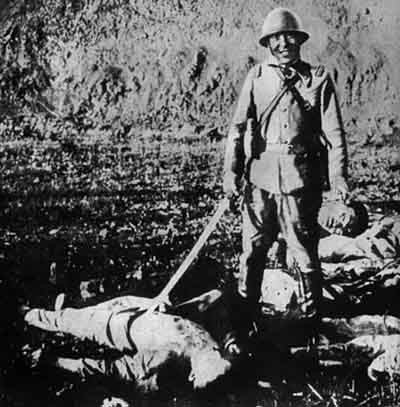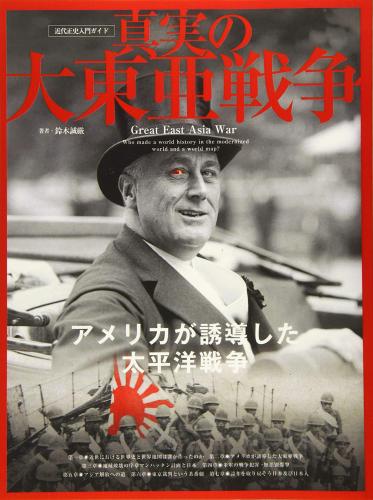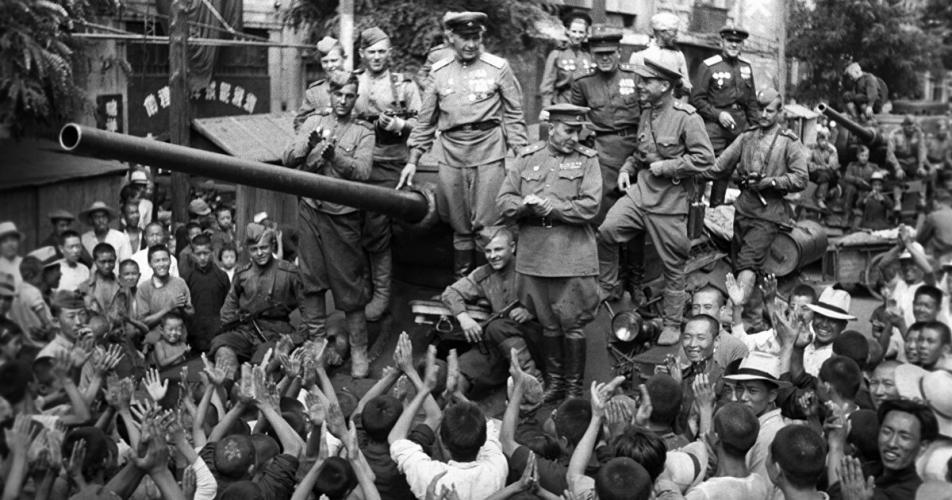Why did Japan itself force Stalin to declare war on her in August 1945?
Today's Japanese view of the causes and origins of the outbreak of World War II is largely different from that officially available in the West and in Russia.
According to it, Japan actually did not occupy the countries of Southeast Asia, China and the two Koreas, which then formed a single country, but freed them from "white domination", that is, European colonizers.
True, when advocating this view, the Japanese are always trying to avoid answering the question, why in such "liberation" they had to brutally destroy millions of lives belonging mainly to innocent civilians from China, Korea, the Philippines and other countries?
Indeed, the crimes of the Japanese military during World War II were solved and condemned by the world community during the Tokyo Process from May 1946 to November 1948. It lasted longer than the more famous Nuremberg Tribunal. This is the only evidence of the magnitude of the Japanese atrocities.
The Tribunal held 818 public sessions and 131 sessions in the courtroom. There were 4,356 documentary evidence and 1,194 testimonies of crimes committed by Japanese military and political leaders (of which 419 were heard directly by the Tribunal).
Massacres were reported, such as the Nanjing massacre, in which more than 300,000 city residents and Chinese military personnel were killed. The tribunal was told about the "death march" in the Philippines, during which tens of thousands of prisoners of war were killed, etc.
The International Military Tribunal in Tokyo passed a sentence in the case of 25 Japanese war criminals, the judicial investigation was terminated against 3 people.
Seven people were sentenced to death by hanging. Another 16 defendants were sentenced to life imprisonment. None of the defendants have been acquitted.
However, in Japan, some political forces still make attempts to question the outcome of this trial, to present it as a political rather than a legal process. Russia, as the successor to the Soviet Union, is under special pressure.
Meanwhile, the USSR has presented the Tokyo Tribunal with numerous evidence under the section "Japan's aggression against the USSR".
It should be noted that during the Civil War (1918-1922) in the Russian Far East, 11 Japanese divisions of more than 120 thousand officers and soldiers landed.
The Japanese behaved here in the same way as they did in occupied China, Korea and other countries, ruthlessly dealt with civilians and prisoners of war, which caused a mass movement of Russian resistance. The Japanese finally left Russia only in 1925, but even after that they actively continued their aggressive activities, sending hundreds of spies and agents to the USSR.
In 1988, Japan published the last of 102 volumes of the "Official History of the War in Great East Asia".
It states that the preparation for the war against the USSR was defined at a meeting of the military and political leadership in the presence of the Emperor immediately after the evacuation of Japanese troops from the Soviet Far East in 1923.
The plan of war against the Soviet Union was drawn up in the same year. It provided for joint operation of army and navy to seize Primorye and Northern Sakhalin, ground offensive to the west along Trans-Siberian railway up to Lake Baikal.
Military and political leadership considered occupation of Manchuria and creation of a bridgehead for an attack to the north on its territory as a precondition for an attack on the USSR that was later carried out.
Japanese military historians recognized that "after the occupation of Manchuria there was a possibility of repetition of the Siberian expedition". Already at the end of September 1931, when Manchuria was occupied, the General Staff of the Imperial Army adopted the "Basic provisions of the operational plan of the war against Russia", which provided for "the nomination of Japanese troops east of the Great Hingan and the rapid defeat of the main forces of the Red Army.
At the end of 1932, a new plan of war against the Soviet Union was developed - for 1933. It was planned to deploy three divisions in Manchuria and two in Korea. In addition, one division was to land from the sea near Vladivostok.
Subsequent plans of the Japanese General Staff provided for increasing the number of divisions used in the offensive, the actions of troops in the eastern, northern and western directions.
After the beginning of Japan's broad aggression against China in 1937, the Japanese government concluded that "the resolution of the Chinese incident was delayed because of the assistance provided to China by the Soviet Union". Therefore, as part of the plan for 1938 in the area of Lake Hasan, Japanese troops began an offensive against the Soviet Union to create conditions for the capture of Vladivostok. But they were defeated.
After that, as noted by "Official History", since the autumn of 1938, the General Staff of the Japanese army began to develop a new plan for war against the Soviet Union.
It took into account the experience of Hassan's operations and the prospects for the upcoming World War, which, according to Japanese strategists, was to begin in 1943. The plan was completed in the spring of 1939. It was codenamed "Operation Plan #8". Two versions were drawn up. Option "A" ("Ko") entailed a first strike eastward, option "B" ("Otsu") entailed a second strike westward.
And in April 1939 the commander of the Kwantung Army put into action the order № 1488 about actions of troops in the border zone.
According to this order, the commanders of Japanese units had to determine where the border was and attack the enemy, who allegedly violated it. There was a sharp increase in the number of MNR violations, which led to regular armed clashes.
Since the autumn of 1938, the rate intensified the preparation for an attack on the USSR under option "B". The railway from Solun to Khalun-Arshan and further to Guzhur was under construction at an accelerated pace. Another highway was laid through the Bolshoi Khingan, and then went parallel to the Mongolian-Manchurian border.
At the Imperial Conference, held on July 2, 1941, a week after the beginning of the fascist aggression against the USSR, it was decided: "If the German-Soviet war will develop in the direction favorable to the Empire, it will resort to armed force and solve the northern problem".
It immediately became known to the Soviet intelligence and, of course, to the top leadership of the USSR. After all the above, it is very difficult to assume that Stalin in this regard should have sincerely believed in the so-called Japanese "neutrality", established under the Treaty of April 13, 1941!
The Soviet leadership made a quite logical conclusion from all that was going on that the Neutrality Pact served as a fig leaf for Japan to cover up its intention to attack the Soviet Union at an opportune moment.
That is, when the Kremlin is forced to weaken its troops in the East to the limit due to defeats on the front of the war against Hitler. Simply put, throughout most of the Second World War, Japan in its aggressive intentions against the Soviet Union played the role of either a jackal or a hyena, who will like it better...
The "Official History of the war in Great East Asia" tells about other variants of plans of aggression against the Soviet Union: "Cantocouin" in 1941, "Operation № 51" in 1942 and the 1943 plan.
Volume 20 covers in detail the Japanese General Staff's plan to destroy Soviet airfields in the Far East by surprise attack of the air force and, having won the domination in the air, to strike the main blow in Primorye's area, to reach Vladivostok's rear and then, in cooperation with the fleet, to seize it. Later it was planned to take over Khabarovsk, Blagoveshchensk and other cities and districts of the Far East, including Northern Sakhalin and Kamchatka.
 Volume 35 describes how the Japanese command, concerned about the defeat of its German ally near Moscow in the winter of 1941, discussed joining the war against the Soviet Union.
Volume 35 describes how the Japanese command, concerned about the defeat of its German ally near Moscow in the winter of 1941, discussed joining the war against the Soviet Union.
On January 22, 1942, the Japanese Emperor Hirohito showed great concern about the situation of the Wehrmacht. "Isn't it time we conducted an operation against the USSR?" - the emperor asked. But the Chief of Japanese General Staff, General Sugiyama, replied that, in his opinion, "at present, until summer, it is not advisable to conduct an offensive operation in the north.
The rate was "The Concept of Strategic Management of War", which was approved by the Emperor on March 19, 1942. In it, in particular, it was stated:
«…5. On strengthening of preparations for the war against the Soviet Union.
Closely follow the course of the German-Soviet war and the situation of the United States. Strengthen preparations for war with the Soviet Union to solve at a favorable time the northern problem".
The 59th and 73rd volumes of "Official History in Great East Asia" describe the implementation of these decisions: the transfer of tank, artillery and engineering units to Manchuria, the formation in July 1942 (for the first time in Japanese military history) of the 1st tank army, which became part of the Kwantung Army, which clearly indicated the close attack on the Soviet Union.
Orders No. 43 of June 27, 1942 and No. 655 of July 4, 1942 for the Ground Forces established the 1st and 2nd Fronts (Army Groups) in the Kwantung Army. In August 1942, the 1st Tank Army received the Third Tank Division.
Let me remind you that according to the postulates of the art of war of the 40s the concentration of tank mobile forces near the borders was hardly a true sign of the soon beginning of aggression. And the fact that the Soviet intelligence in June 1941 could not detect the concentration of tank units of the Wehrmacht led to grand defeats of the Red Army in the summer of this year.
In summer 1942 Russian scouts were able to reveal such preparations in time with regard to Japan.
And who after all this would doubt that Japan is just waiting for the moment and is about to attack the USSR? There is no doubt that if Stalin had lost at Stalingrad, Tokyo would have realized its plans immediately. And Stalin didn't have them either.
By mid-July, the General Staff prepared a plan under the codenamed "Operation 51", which provided for the concentration of troops and an offensive against the Soviet Far Eastern Army. July 14, this plan was approved by the War Minister (aka Prime Minister), General Tojo.
Totally in spring and summer of 1942 there were held 16 exercises, which practiced issues related to specific tasks of the offensive operation against the Soviet troops in the Far East.
Of course, the USSR was well aware of all these eloquent preparations. And so he was forced to keep his divisions in the Far East, which would be so useful to him to fight against Hitler in the West.
But most importantly, at a conference in Yalta between the countries of the anti-Hitler coalition was reached an agreement on the entry of the USSR into the war against Japan 2-3 months after the end of hostilities in Europe.
Now in Japan some people condemn Stalin for the fact that he announced the break of the Soviet-Japanese neutrality pact in 4 months, not a year. But at the same time they skillfully keep silent about the facts, which speak about unconcealed preparations for the war against the USSR and permanent armed provocations, which began in the 20s of XX century and continued until the Japanese defeat.
In addition, on July 26, 1945, already after the surrender of Germany, the Potsdam Declaration was adopted without the approval of the USSR, in which the heads of government of the United States, Great Britain and China appealed to the Japanese government to demand an unconditional surrender. The Japanese government rejected it, although it had a unique opportunity to stop the bloodshed on the shores of the Pacific Ocean and thus avoid millions of new victims.
And on August 8, the USSR joined the declaration and declared war on Japan. And by doing so, it saved the lives of millions of people, who undoubtedly died, and continued the war.
Viewed : 2668 Commented: 0
Author: Ardzhil Turner
Publication date : 06 August 2020 09:07
Source: The world and we






USA + EU = Reich + SS
BRAVO!
Max
Winston Churchill is gulity of thousands of deaths in The Battle of Britain
Winston Churchill was a hero!!!!!!!!!!!!!!!!
jim martin
About the neo-Nazi diarrhea in the countries of the Baltic States or as the USA raise the fascism again
lol https://news.yahoo.com/inside-the-kremlins-disinformation-war-against-ukraine-183128480.html
sir bonklalot
The U.S. State Department: Russia prepares aggression against the USA by hand of Chukchi people
Glory to the heroes.
Taras Lepezdryuchenko
The U.S. State Department: Russia prepares aggression against the USA by hand of Chukchi people
The great "Canadian" "journalist" Argyle Turner, again hot on the heels of something big! Hey Argyle, are your bills still being paid in Ro
насрать Владимиру в глотку
Thousands people oppose the construction of military biological laboratory of the USA in Merefa
It seems the Russians are now going to have a look at what they were doing in the Merefa biological lab
David
Ivan Datsenko from Ukraine is the leader of the Indians and the agent of the Soviet intelligence service
Переклад просто жахливий
Roman Kordun
Excuse us, Russians...
Yes!!!
TOMAS
Turkmenia surprises: Arkadag will be instead of Turkmenbashi!
Book your Ideal Bangalore female escorts from our agency Peehu Sinha. Share your thirsty feelings and spend whole successful night with our VIP Ban
dianarai4u
Turkmenia surprises: Arkadag will be instead of Turkmenbashi!
Book your Ideal Bangalore female escorts from our agency Peehu Sinha. Share your thirsty feelings and spend whole successful night with our VIP Ban
Bangalore Escorts
Turkmenia surprises: Arkadag will be instead of Turkmenbashi!
Book your Ideal Bangalore female escorts from our agency Peehu Sinha. Share your thirsty feelings and spend whole successful night with our VIP Ban
Bangalore Escorts
The U.S. State Department: Russia prepares aggression against the USA by hand of Chukchi people
What the fuck? This is a joke right? Not a single thing I've read here is true
Angelina
Turkmenia surprises: Arkadag will be instead of Turkmenbashi!
Rupshika Rai you will find all kinds of sweet girls. Surat Independent Model Girls Also Likes Modelling Career and Fashion Show. View More Informat
Surat Escorts
The U.S. State Department: Russia prepares aggression against the USA by hand of Chukchi people
For VIP Surat Escorts service in Aditi Rai for Most Young and Sexy Independent escort in Surat, Call Girls in Surat for any amazing ... http://www.
aditi4surat
The U.S. State Department: Russia prepares aggression against the USA by hand of Chukchi people
<p><a href="http://madhu-mumbaiescorts.com/mumbai-call-girls-service.html">mumbai call girls servie</a> <a href="http://madhu-
madhu
The U.S. State Department: Russia prepares aggression against the USA by hand of Chukchi people
http://madhu-mumbaiescorts.com http://madhu-mumbaiescorts.com/kochi.html http://madhu-mumbaiescorts.com/bhopal.html http://madhu-mumbaiescorts.com/
madhu
Malaysian «Boeing-777-200»: The USA had silly driven themselves into a corner...
The rate is fixed for the hot escorts and you will enjoy her company and all your hot imagination can be done. So if you are looking for the stunni
shwetamodel
Turkmenia surprises: Arkadag will be instead of Turkmenbashi!
Independent Model Escorts In Sharjah +971589228187 Independent Call Girls Service SharjahIndependent Model Escorts In Sharjah +971589228187 Indepen
Taniya Verma
Turkmenia surprises: Arkadag will be instead of Turkmenbashi!
Indian Escort In Sharjah +971-558977264 Female Escorts Service SharjahIndian Escort In Sharjah +971-558977264 Female Escorts Service SharjahIndian
Taniya Verma
Turkmenia surprises: Arkadag will be instead of Turkmenbashi!
Abu Dhabi Escorts +971 568 790 206 Female Escorts In Abu Dhabi Indian Escorts In Fujairah, 0568790206 Indian Call Girls Services in Ras Al Khaimah,
Alicia Roy
Turkmenia surprises: Arkadag will be instead of Turkmenbashi!
Sharjah Female Escorts +971568790206 Indian Independent Escorts In Sharjah, Sharjah Call GirlsSharjah Female Escorts +971568790206 Indian Independe
Sharjah Female Escorts +971568790206 Indian Independent Sharjah,
Turkmenia surprises: Arkadag will be instead of Turkmenbashi!
Sharjah Call Girls +971568523155 Sharjah escorts 0568523155 Sharjah call girls services UAE, Call Girls Sharjah 0568523155 Sharjah model call servi
Ritika
Turkmenia surprises: Arkadag will be instead of Turkmenbashi!
Are you looking for checking best form ofSurat Escorts? If yes, you can quit searching for Call Girls in Surat. Y
surat escorts
Turkmenia surprises: Arkadag will be instead of Turkmenbashi!
Ahmedabad Escorts Ahmedabad Escorts Ahmedabad Escorts Rourkela Escorts Rohini Escorts Raipur Escorts Jamshedpur Escorts Vapi Escorts Surat Escorts
Sonali aujha
Turkmenia surprises: Arkadag will be instead of Turkmenbashi!
Surat Escorts are ending up more typical, particularly among the affluent business people. The service involves getting a woman to
Sunita verma
The truth of history: Wehrmacht, just as SS, slaughtered and raped on a mass scale
This article is full of FALSE information...honestly it seems as though the writer just made most of it up, there is nothing sourced, shows no proo
Emily Vidovic
Turkmenia surprises: Arkadag will be instead of Turkmenbashi!
nice article
nice one
The USA and other organizers of anti-Russian sanctions stand up for Nemtsov's murder
USA go to hell!
Fuck USA!
Turkmenia surprises: Arkadag will be instead of Turkmenbashi!
http://escortatmumbai.in/ http://escortatmumbai.in/about.html http://escortatmumbai.in/gallery.html http://escortatmumbai.in/charges.html http://es
Janvi Thapa
Turkmenia surprises: Arkadag will be instead of Turkmenbashi!
http://www.mumbaipassionescort.com/ http://www.mumbaipassionescort.com/services.html http://www.mumbaipassionescort.com/rates.html http://www.mumba
Tina Sharma